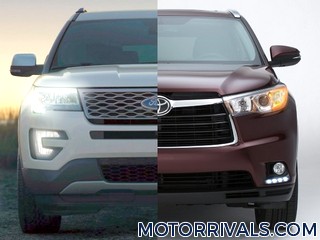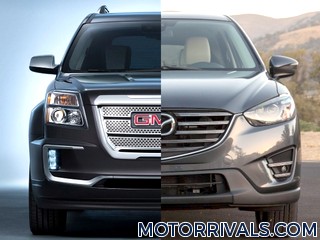2016 Mazda CX-9 vs 2016 Honda Pilot
Mazda Press Release Highlights
With the new CX-9, engineers sought to instill driving dynamics befitting of a Mazda—agile handling, tight steering and a responsive, controllable powertrain. To do this, they found smart solutions to keep CX-9’s structure light, yet rigid, with SKYACTIV Technology. They developed a new turbocharged SKYACTIV-G 2.5T engine that delivers instant throttle response, class-leading torque and an estimated around 20-percent increase in fuel- efficiency, based on initial estimates of U.S. EPA testing cycles, making CX-9 among the most efficient vehicles in its class.
Powertrain
When Mazda’s engineers set out to design a new engine specifically for CX-9, they looked at how drivers used their vehicles. Customers want effortless acceleration through bountiful torque delivery, so engineers developed the SKYACTIV-G 2.5T with enough power and torque to provide ample acceleration without having to hunt through the gears.One piece of technology is Mazda’s Dynamic Pressure Turbo, the world’s first turbocharger with the ability to vary the degree of exhaust pulsation depending on engine speed. The system routes engine exhaust to the turbocharger’s turbine through smaller ports at low rpm. It works similarly to when one might place his or her thumb on a garden hose, creating a strong amount of pressure through a smaller outlet. This allows the turbocharger to spool up quickly, creating instant boost—up to 1.2 bar (17.4 psi) of pressure. When the engine is in the heart of its rev range, it opens up secondary valves, allowing for greater amounts of exhaust gas to pass through the turbocharger. The system is complemented by the 2.5-liter engine that already benefits from more torque at atmospheric pressure than a comparable 2.0-liter by virtue of its size.
The net result: 310 lb-ft (420 N-m) of torque at a low 2,000 rpm and 250 horsepower at 5,000 rpm on 93-octane gasoline (227 horsepower on 87-octane gasoline). At 55 mph (88 km/h), a driver needs just 18 horsepower to maintain speed on flat roads with a front- wheel-drive model—a four-horsepower reduction versus the outgoing model, illustrating reduced friction in all parts of the driveline and enhanced aerodynamics.
Safety
Mazda has been a leader in building safer vehicles through several methods:
- Provide an optimum driving environment with well-positioned controls, easy-to-read instruments, minimal driver distractions and good visibility.
- i-ACTIVSENSE, which provides active safety features like Mazda Radar Cruise
- Control (MRCC) and Blind Spot Monitoring (BSM).
- Passive safety, which is designed to make the structure and onboard features such that they protect occupants in the case of an accident.
Chassis
Mazda’s class-leading chassis dynamics and outstanding HMI technologies advance the notion of purposeful technology that reduces clutter and improves the driving experience. A lighter, yet more rigid, chassis and straight load-path frame rails integrated into the unibody secure crash protection in the event of a collision and lighter weight improves braking performance with 12.6-inch (320mm) ventilated front disc brakes and 12.8-inch solid rear discs (325mm). Those brakes are unchanged in size from the previous model, but they now have approximately 198 fewer lbs. (90 kg) to halt.
i-ACTIV AWD upped the ante, implementing a host of other sensors that were already integrated into vehicles for other functions and channeling the information they presented such as ambient temperature, steering wheel angle, longitudinal grip, brake fluid pressure and even windshield wiper movement. In all, i-ACTIV AWD brings 27 different sensors together to paint a picture of road conditions and direct torque to the rear wheel as necessary, predicting what the driver may face on a slick road in the winter or in heavy rain.
Technology
New CX-9 comes with a seven-inch or eight-inch MAZDA CONNECT touchscreen infotainment system standing front and center for connectivity needs with commander control knob. Using both touchscreen functions when parked and a center-mounted commander control knob when on the move, MAZDA CONNECT intuitively and safety control radio, phone, navigation, diagnostic and phone functions. MAZDA CONNECT also enables voice controls for many functions as well as five shortcut buttons around the commander control for selecting favorite radio channels or enabling specific functions.
The driver also has an available 4.6-inch, full-color TFT screen in the gauges for many of these information readouts in addition to Active Driving Display, a full-color head-up display projected onto the lower windshield for readouts from the navigation, cruise control and other functions.
In back, passengers have two 2.1-amp USB ports available for charging smartphones or tablets, each mounted in the outboard passenger armrests.
Last but not least is the new Bose premium audio system, which is designed to deliver outstanding clarity, image and range. The 12-speaker system—two additional speakers from the previous CX-9’s Bose premium audio system—was benchmarked against stereos from ultra-premium crossover utility vehicles using several different audio formats, including radio and both full and compressed digital formats.
Honda Press Release Highlights
Technology
The new Pilot delivers the connectivity and power access that the modern family demands, including up to five USB ports, four that provide better recharging with 2.5-amp output, to charge iPads or smartphones while in use. Additional ports and plugs include an auxiliary jack for nearly any audio player, an HDMI port for a gaming console, two headphone jacks, two 12-volt power outlets and a 115-volt outlet to power just about anything.
The new Pilot also incorporates Honda's latest thinking for advanced, family-friendly technology, including an upsized 8-inch capacitive touchscreen Display Audio telematics interface powered by a new Android-based operating system and more powerful processor, along with an available all-new embedded Honda Satellite-Linked Navigation System™. The new navigation system features improved graphics and new capabilities, including 3D renderings of terrain, buildings and road signs, improved lane guidance, live search function, 911 emergency services and more.
The Pilot's Display Audio system enables simplified smartphone connectivity making for easier access to all the features and connectivity options of the HondaLink™ connected-car system. A 9-inch rear entertainment system with DVD and new Blu-Ray disc™ capability is available.
Powertrain
The 2016 Pilot delivers more refined, powerful and fuel-efficient performance than ever before courtesy of its new 3.5-liter, direct-injected i-VTEC® V-6 engine with Variable Cylinder Management™ (VCM™) cylinder deactivation technology. For improved fuel efficiency, the Pilot will include available Idle Stop technology that shuts off the engine when the vehicle is stopped, instantly and smoothly restarting the engine when the driver lifts their foot off the brake pedal. The new engine is mated to one of two advanced new transmissions – a Pilot-first 6-speed automatic transmission, or on upper trims, a Honda-first 9-speed automatic transmission – both delivering notably refined, responsive and fuel-efficient performance. The new Pilot will be available in front-wheel and all-wheel-drive configurations and will feature a completely new Honda all-wheel-drive system that delivers even more confident, efficient and dynamic all-weather performance.
Chassis
The new Pilot is almost 300 pounds lighter than the outgoing model; its more rigid, tightly sealed yet lighter body in combination with new, efficient powertrains, a new all-wheel-drive system and class-leading aerodynamics result in class-leading dynamic performance and fuel efficiency along with a new level of cabin quietness befitting its status as a premium family SUV.
Safety
In keeping with Honda's commitment to safety, the new Pilot will feature the most comprehensive set of advanced safety and driver-assistive technologies ever offered on a Honda vehicle. Together these technologies make up Honda Sensing™, a suite of technologies designed to expand the driver's situational awareness while sensing and responding to potential road hazards, including other vehicles, road obstacles and even pedestrians, mitigating the possibility or severity of a collision. It includes Honda's popular LaneWatch™ display, Blind Spot Indicators, a standard Multi-Angle Rear View Camera, and available Collision Mitigation Braking System™ (CMBS), Lane Departure Warning (LDW), Forward Collision Warning (FCW), Lane Keeping Assist System (LKAS), Rear Cross Traffic Monitor, Adaptive Cruise Control and a Honda-first Road Departure Mitigation (RDM) system.




















